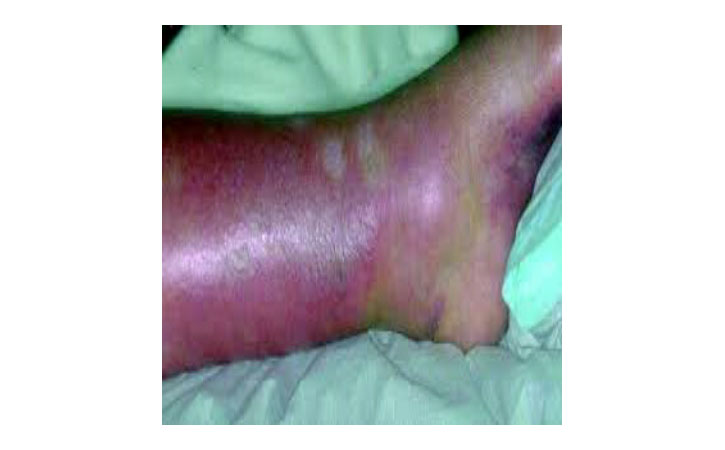Mycetoma
Mycetoma (Madura foot)) is a chronic, progressively destructive infectious disease of the subcutaneous tissues, affecting skin, muscle and bone usually of the foot but any part of the body can be affected. Mycetoma can be caused by different species of microorganisms, but almost always by bacteria or fungus. Mycetoma occurs in tropical and subtropical environments characterized by short rainy seasons and prolonged dry seasons that the growth of thorny bushes. Global burden is not known, but the disease is endemic has been reported from countries in Africa, Asia, Europe and Latin America. Mycetoma has numerous adverse medical, health and socioeconomic consequences for patients, communities and health services in affected areas. People living in or travelling to endemic areas should be advised not to walk barefoot, as footwear and clothing in general can protect against puncture wounds.

Mycetoma commonly affects young adults, mostly males aged between 15 and 30 years in developing countries. People of low socioeconomic status and manual workers such as agriculturalists, labourers and herdsmen are the worst affected.
Mycetoma has numerous adverse medical, health and socioeconomic impacts on patients, communities and health authorities. Early detection and treatment are important to reduce morbidity and improve treatment outcomes.
Mycetoma is characterized by a combination of painless subcutaneous mass, multiple sinuses and discharge containing grains. It usually spreads to involve the skin, deep structures and bone, resulting in destruction, deformity and loss of function, which may be fatal. Mycetoma commonly involves the extremities, back and gluteal region but any other part of the body can be affected. Given its slow progression, painless nature, lack of awareness, and scarcity of medical and health facilities in endemic areas, many patients present late with advanced infection where amputation may be the only available treatment. Secondary bacterial infection is common, and that may cause increased pain, disability and fatal septicaemia (severe infections involving the entire human system), if untreated. Infection is not transmitted from human to human.
This is a chronic infection of the dermis and subcutaneous fat caused by various species of fungus (eumycetoma) or bacteria (actinomycetoma).
Fungus (eumycetoma): Caused by true fungi, including pigmented fungi such as Madurella spp, and hyaline fungi such as Pseudallescheria.
Bacteria (actinomycetoma): Caused by Nocardia, Actinomadura, and Streptomyces.
The treatment depends on the causative organisms for the bacterial type; it is a long term antibiotics combination whereas for fungal type it is combined antifungal drugs and surgery.
Eumycetoma:
- Itraconazole 200mgtwice daily for at least 12 months if it is affordable.
If not improved
- Surgical excision of affected tissue if disease is limited.
- Amputation if extensive.
Actinomycetoma:
- Sulfamethoxazole-trimethoprim mixture 960mgtwice daily for up to two years.
Preventing infection is difficult, but people living in or travelling to endemic areas should be advised not to walk barefooted.
- WHO
- ABC Of Dermatology
- Clinical Dermatology
- Andrew’s Diseases of the skin
Mycetoma
TUI - Tibot Urgency Index


Mycetoma (Madura foot)) is a chronic, progressively destructive infectious disease of the subcutaneous tissues, affecting skin, muscle and bone usually of the foot but any part of the body can be affected. Mycetoma can be caused by different species of microorganisms, but almost always by bacteria or fungus. Mycetoma occurs in tropical and subtropical environments characterized by short rainy seasons and prolonged dry seasons that the growth of thorny bushes. Global burden is not known, but the disease is endemic has been reported from countries in Africa, Asia, Europe and Latin America. Mycetoma has numerous adverse medical, health and socioeconomic consequences for patients, communities and health services in affected areas. People living in or travelling to endemic areas should be advised not to walk barefoot, as footwear and clothing in general can protect against puncture wounds.



Mycetoma commonly affects young adults, mostly males aged between 15 and 30 years in developing countries. People of low socioeconomic status and manual workers such as agriculturalists, labourers and herdsmen are the worst affected.
Mycetoma has numerous adverse medical, health and socioeconomic impacts on patients, communities and health authorities. Early detection and treatment are important to reduce morbidity and improve treatment outcomes.
Mycetoma is characterized by a combination of painless subcutaneous mass, multiple sinuses and discharge containing grains. It usually spreads to involve the skin, deep structures and bone, resulting in destruction, deformity and loss of function, which may be fatal. Mycetoma commonly involves the extremities, back and gluteal region but any other part of the body can be affected. Given its slow progression, painless nature, lack of awareness, and scarcity of medical and health facilities in endemic areas, many patients present late with advanced infection where amputation may be the only available treatment. Secondary bacterial infection is common, and that may cause increased pain, disability and fatal septicaemia (severe infections involving the entire human system), if untreated. Infection is not transmitted from human to human.
This is a chronic infection of the dermis and subcutaneous fat caused by various species of fungus (eumycetoma) or bacteria (actinomycetoma).
Fungus (eumycetoma): Caused by true fungi, including pigmented fungi such as Madurella spp, and hyaline fungi such as Pseudallescheria.
Bacteria (actinomycetoma): Caused by Nocardia, Actinomadura, and Streptomyces.
The treatment depends on the causative organisms for the bacterial type; it is a long term antibiotics combination whereas for fungal type it is combined antifungal drugs and surgery.
Eumycetoma:
- Itraconazole 200mgtwice daily for at least 12 months if it is affordable.
If not improved
- Surgical excision of affected tissue if disease is limited.
- Amputation if extensive.
Actinomycetoma:
- Sulfamethoxazole-trimethoprim mixture 960mgtwice daily for up to two years.
Preventing infection is difficult, but people living in or travelling to endemic areas should be advised not to walk barefooted.
- WHO
- ABC Of Dermatology
- Clinical Dermatology
- Andrew’s Diseases of the skin




